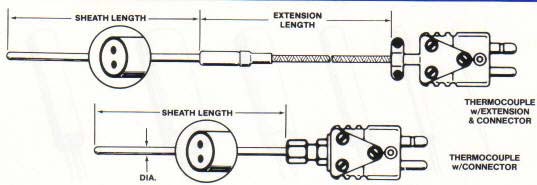Products
Sensors - Marlox Thermocouples - High Temperature Metal-Sheathed Thermocouples

Sensors - Marlox Thermocouples - High Temperature Metal-Sheathed Thermocouples
 |
|---|
| Thermocouple Type | Maximum
Operating Temperature
|
Maximum Exposure Temperature | Recommended Environment |
|---|---|---|---|
| Pt-10%
Rh/Pt ANSI Type S |
2700°F 1482°C |
3100°F 1704°C |
Oxidizing, Inert |
| Pt-13%
Rh/Pt ANSI Type R |
2700°F 1482°C |
3100°F 1704°C |
Oxidizing, Inert |
| Pt-30%
Rh/Pt-6% Rh ANSI Type B |
3100°F 1704°C |
3220°F 1770°C |
Oxidizing, Inert |
| W-5%
Re/W-26% Re Type (C) |
5000°F 2760°C |
5430°F 3000°C |
Vacuum,
High Purity Hydrogen & Inert |
Pt-Platinum, Rh-Rhodium, W-Tungsten, Re-Rhenium
| SHEATH SIZE - WIRE GAUGE | ||||
|---|---|---|---|---|
| Sheath
Diameter Inches |
0.062 | 0.125 | 0.187 | 0.250 |
| Wire
Gauge B & S |
30 | 30 | 24 | 24 |
Sheath Alloys:
| Sheath Material | Approximate Melting Temperature | Maximum Operating Temperature | Recommended Environment |
|---|---|---|---|
| Platinum | 3217°F 1770°C |
3000°F 1650°C |
Oxidizing, Inert |
| Platinum 10% Rhodium |
3362°F 1850°C |
3100°F 1705°C |
Oxidizing, Inert |
| Tantalum | 5425°F 2996°C |
4500°F 2482°C |
Vacuum |
| *Molybdenum | 4730°F 2610°C |
4000°F 2205°C |
Vacuum, Inert |
*Moly
50% Rhenium 50% |
4424°F 2440°C |
4000°F 2205°C |
Vacuum,
Hydrogen Nitrogen, Inert Cracked Ammonia |
*Not suitable for swaging.
REFRACTORY OXIDE INSULATORS
The resistivity of metal oxides decreases with increasing temperature. Above 3600°F only Hafnia retains sufficient resistivity for most applications.
| Insulator Material | Approximate Melt Temperature | Maximum Recommended Temperature | |
|---|---|---|---|
| Hard-Fired | Swaged | ||
| Magnesia MgO |
5070°F 2800°C |
N/A | 3400°F 1870°C |
| Alumina Al2O3 |
3650°F 2010°C |
3200°F 1760°C |
3000°F 1650°C |
| Hafnia HfO2 |
5126°F 2830°C |
4000°F 2200°C |
N/A |
